Business Finance Report: Bright Lawns Ltd and Budgetary Systems
VerifiedAdded on 2023/01/19
|10
|3010
|67
Report
AI Summary
This business finance report delves into core concepts such as profit, cash flow, working capital, receivables, inventory, and payables. It explains the differences between profit and cash flow, and how changes in working capital affect cash flow statements. The report applies these concepts to a case study of Bright Lawns Ltd, analyzing their financial performance and identifying issues related to outstanding amounts and employee management. It provides recommendations to improve cash flow through working capital management, including reducing credit periods and minimizing operational expenses. Furthermore, the report explores the purposes of budgeting, examining traditional (incremental) and alternative (rolling, zero-based, activity-based) budgetary systems, evaluating their strengths and weaknesses, and assessing their suitability for different parts of a business. The report emphasizes the importance of effective financial management for organizational success and strategic decision-making.
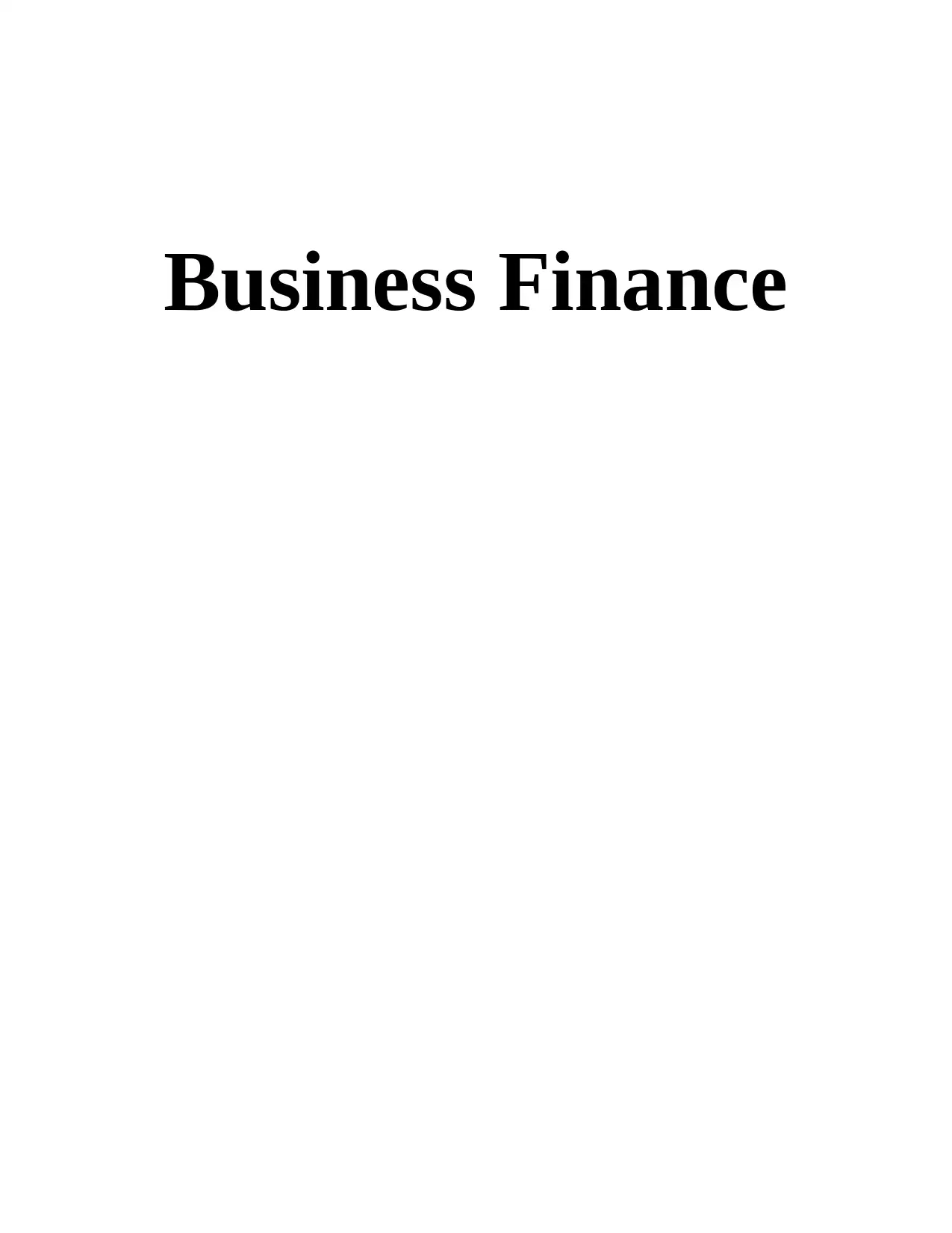
Business Finance
Paraphrase This Document
Need a fresh take? Get an instant paraphrase of this document with our AI Paraphraser
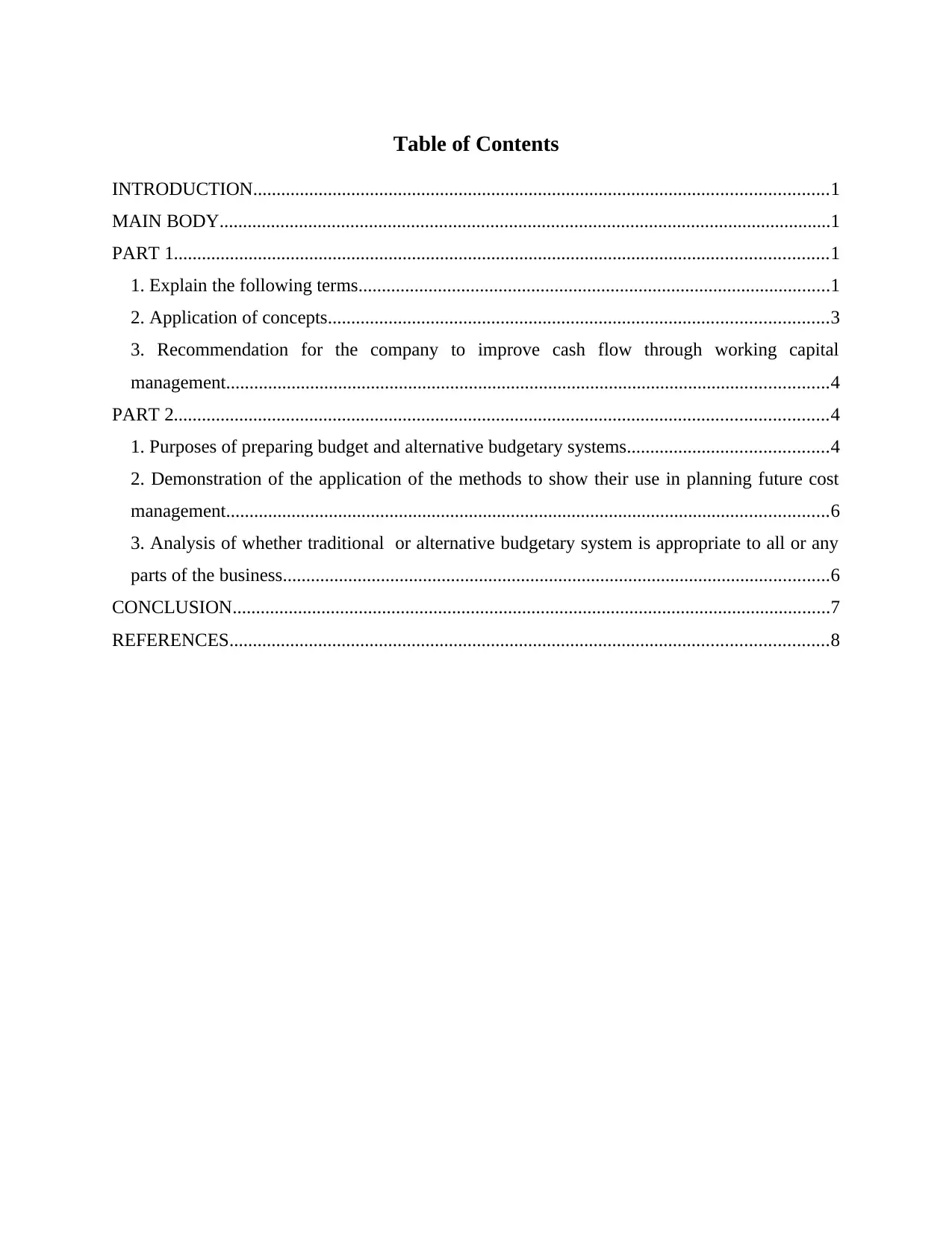
Table of Contents
INTRODUCTION...........................................................................................................................1
MAIN BODY...................................................................................................................................1
PART 1............................................................................................................................................1
1. Explain the following terms.....................................................................................................1
2. Application of concepts...........................................................................................................3
3. Recommendation for the company to improve cash flow through working capital
management.................................................................................................................................4
PART 2............................................................................................................................................4
1. Purposes of preparing budget and alternative budgetary systems...........................................4
2. Demonstration of the application of the methods to show their use in planning future cost
management.................................................................................................................................6
3. Analysis of whether traditional or alternative budgetary system is appropriate to all or any
parts of the business.....................................................................................................................6
CONCLUSION................................................................................................................................7
REFERENCES................................................................................................................................8
INTRODUCTION...........................................................................................................................1
MAIN BODY...................................................................................................................................1
PART 1............................................................................................................................................1
1. Explain the following terms.....................................................................................................1
2. Application of concepts...........................................................................................................3
3. Recommendation for the company to improve cash flow through working capital
management.................................................................................................................................4
PART 2............................................................................................................................................4
1. Purposes of preparing budget and alternative budgetary systems...........................................4
2. Demonstration of the application of the methods to show their use in planning future cost
management.................................................................................................................................6
3. Analysis of whether traditional or alternative budgetary system is appropriate to all or any
parts of the business.....................................................................................................................6
CONCLUSION................................................................................................................................7
REFERENCES................................................................................................................................8
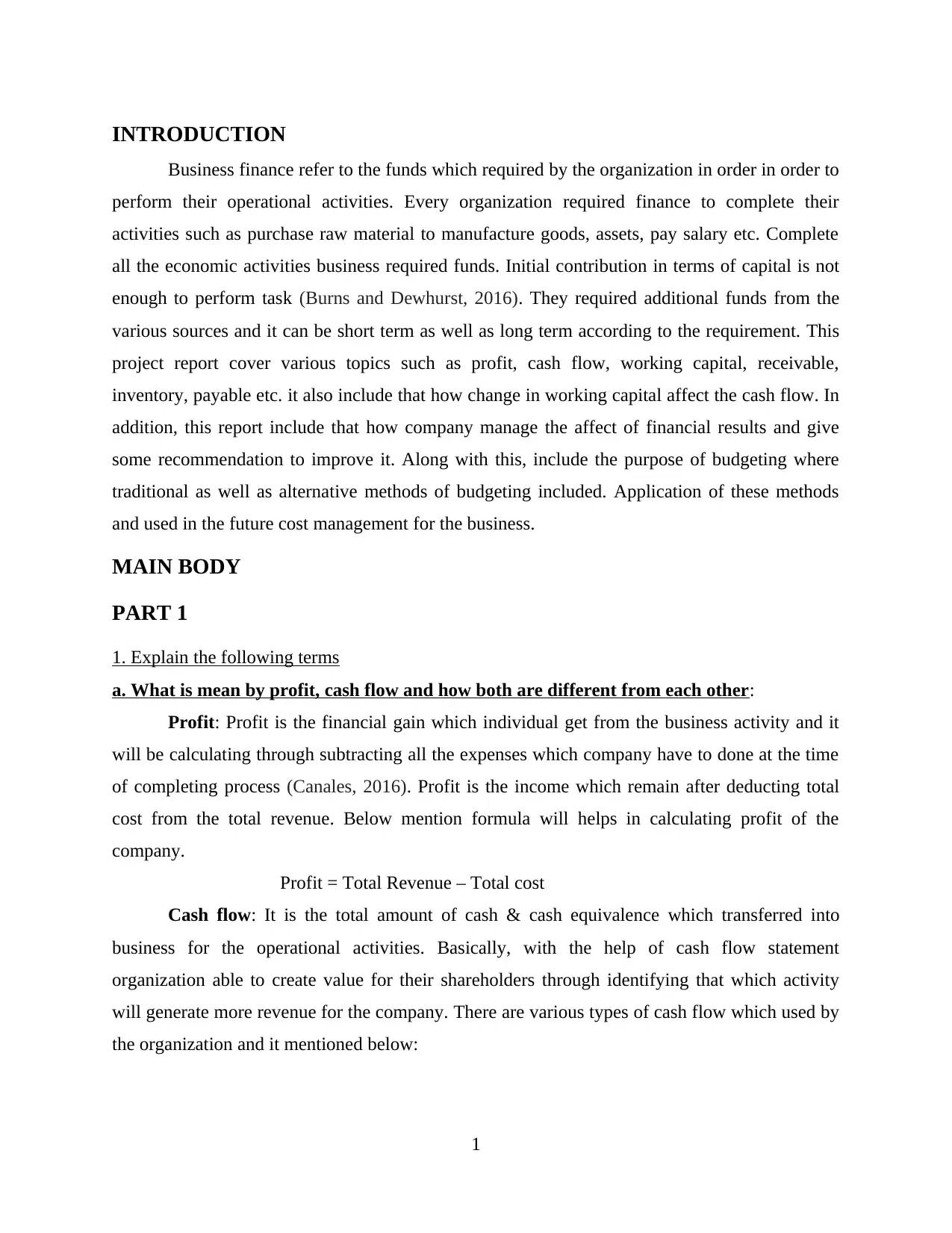
INTRODUCTION
Business finance refer to the funds which required by the organization in order in order to
perform their operational activities. Every organization required finance to complete their
activities such as purchase raw material to manufacture goods, assets, pay salary etc. Complete
all the economic activities business required funds. Initial contribution in terms of capital is not
enough to perform task (Burns and Dewhurst, 2016). They required additional funds from the
various sources and it can be short term as well as long term according to the requirement. This
project report cover various topics such as profit, cash flow, working capital, receivable,
inventory, payable etc. it also include that how change in working capital affect the cash flow. In
addition, this report include that how company manage the affect of financial results and give
some recommendation to improve it. Along with this, include the purpose of budgeting where
traditional as well as alternative methods of budgeting included. Application of these methods
and used in the future cost management for the business.
MAIN BODY
PART 1
1. Explain the following terms
a. What is mean by profit, cash flow and how both are different from each other:
Profit: Profit is the financial gain which individual get from the business activity and it
will be calculating through subtracting all the expenses which company have to done at the time
of completing process (Canales, 2016). Profit is the income which remain after deducting total
cost from the total revenue. Below mention formula will helps in calculating profit of the
company.
Profit = Total Revenue – Total cost
Cash flow: It is the total amount of cash & cash equivalence which transferred into
business for the operational activities. Basically, with the help of cash flow statement
organization able to create value for their shareholders through identifying that which activity
will generate more revenue for the company. There are various types of cash flow which used by
the organization and it mentioned below:
1
Business finance refer to the funds which required by the organization in order in order to
perform their operational activities. Every organization required finance to complete their
activities such as purchase raw material to manufacture goods, assets, pay salary etc. Complete
all the economic activities business required funds. Initial contribution in terms of capital is not
enough to perform task (Burns and Dewhurst, 2016). They required additional funds from the
various sources and it can be short term as well as long term according to the requirement. This
project report cover various topics such as profit, cash flow, working capital, receivable,
inventory, payable etc. it also include that how change in working capital affect the cash flow. In
addition, this report include that how company manage the affect of financial results and give
some recommendation to improve it. Along with this, include the purpose of budgeting where
traditional as well as alternative methods of budgeting included. Application of these methods
and used in the future cost management for the business.
MAIN BODY
PART 1
1. Explain the following terms
a. What is mean by profit, cash flow and how both are different from each other:
Profit: Profit is the financial gain which individual get from the business activity and it
will be calculating through subtracting all the expenses which company have to done at the time
of completing process (Canales, 2016). Profit is the income which remain after deducting total
cost from the total revenue. Below mention formula will helps in calculating profit of the
company.
Profit = Total Revenue – Total cost
Cash flow: It is the total amount of cash & cash equivalence which transferred into
business for the operational activities. Basically, with the help of cash flow statement
organization able to create value for their shareholders through identifying that which activity
will generate more revenue for the company. There are various types of cash flow which used by
the organization and it mentioned below:
1
⊘ This is a preview!⊘
Do you want full access?
Subscribe today to unlock all pages.

Trusted by 1+ million students worldwide
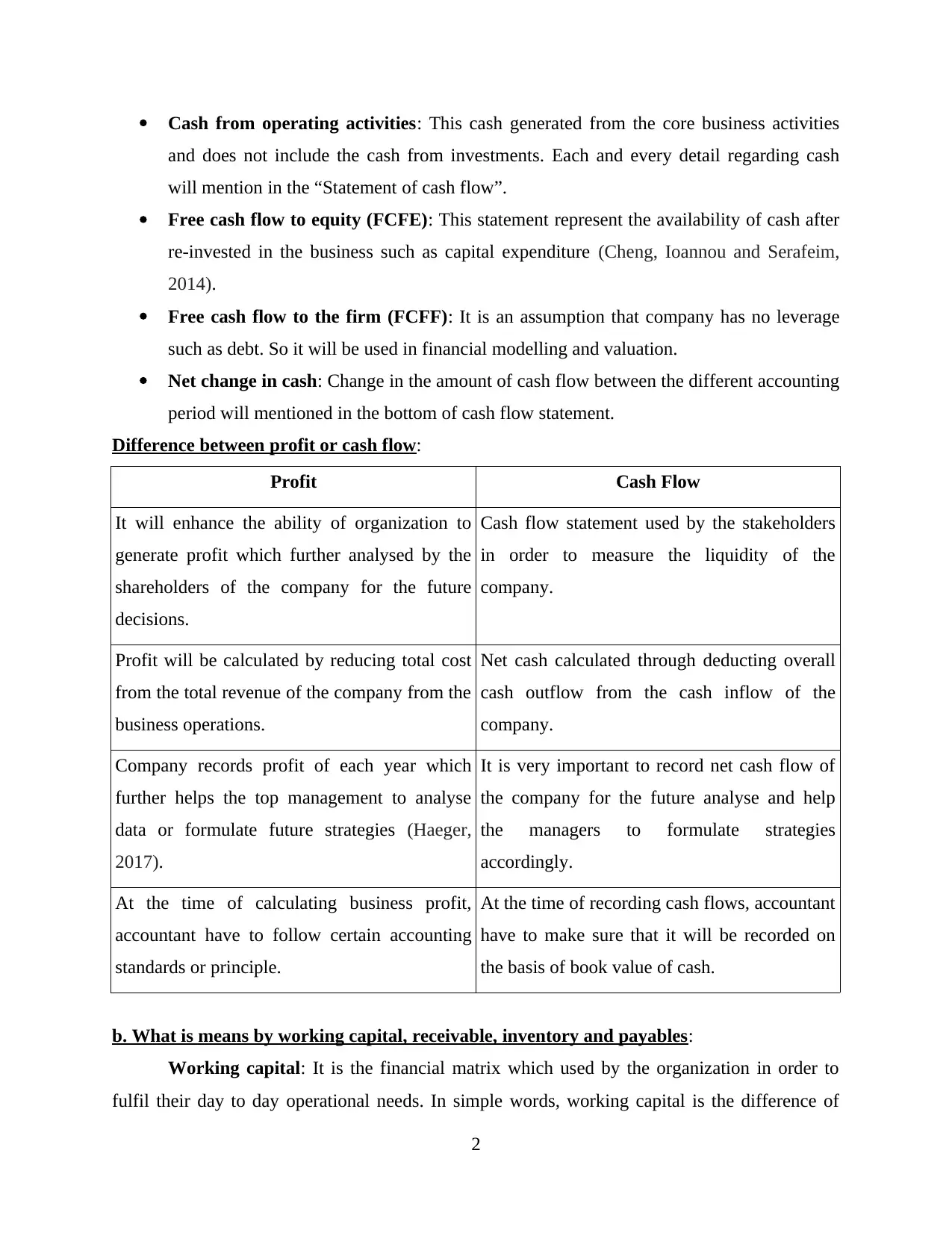
Cash from operating activities: This cash generated from the core business activities
and does not include the cash from investments. Each and every detail regarding cash
will mention in the “Statement of cash flow”.
Free cash flow to equity (FCFE): This statement represent the availability of cash after
re-invested in the business such as capital expenditure (Cheng, Ioannou and Serafeim,
2014).
Free cash flow to the firm (FCFF): It is an assumption that company has no leverage
such as debt. So it will be used in financial modelling and valuation.
Net change in cash: Change in the amount of cash flow between the different accounting
period will mentioned in the bottom of cash flow statement.
Difference between profit or cash flow:
Profit Cash Flow
It will enhance the ability of organization to
generate profit which further analysed by the
shareholders of the company for the future
decisions.
Cash flow statement used by the stakeholders
in order to measure the liquidity of the
company.
Profit will be calculated by reducing total cost
from the total revenue of the company from the
business operations.
Net cash calculated through deducting overall
cash outflow from the cash inflow of the
company.
Company records profit of each year which
further helps the top management to analyse
data or formulate future strategies (Haeger,
2017).
It is very important to record net cash flow of
the company for the future analyse and help
the managers to formulate strategies
accordingly.
At the time of calculating business profit,
accountant have to follow certain accounting
standards or principle.
At the time of recording cash flows, accountant
have to make sure that it will be recorded on
the basis of book value of cash.
b. What is means by working capital, receivable, inventory and payables:
Working capital: It is the financial matrix which used by the organization in order to
fulfil their day to day operational needs. In simple words, working capital is the difference of
2
and does not include the cash from investments. Each and every detail regarding cash
will mention in the “Statement of cash flow”.
Free cash flow to equity (FCFE): This statement represent the availability of cash after
re-invested in the business such as capital expenditure (Cheng, Ioannou and Serafeim,
2014).
Free cash flow to the firm (FCFF): It is an assumption that company has no leverage
such as debt. So it will be used in financial modelling and valuation.
Net change in cash: Change in the amount of cash flow between the different accounting
period will mentioned in the bottom of cash flow statement.
Difference between profit or cash flow:
Profit Cash Flow
It will enhance the ability of organization to
generate profit which further analysed by the
shareholders of the company for the future
decisions.
Cash flow statement used by the stakeholders
in order to measure the liquidity of the
company.
Profit will be calculated by reducing total cost
from the total revenue of the company from the
business operations.
Net cash calculated through deducting overall
cash outflow from the cash inflow of the
company.
Company records profit of each year which
further helps the top management to analyse
data or formulate future strategies (Haeger,
2017).
It is very important to record net cash flow of
the company for the future analyse and help
the managers to formulate strategies
accordingly.
At the time of calculating business profit,
accountant have to follow certain accounting
standards or principle.
At the time of recording cash flows, accountant
have to make sure that it will be recorded on
the basis of book value of cash.
b. What is means by working capital, receivable, inventory and payables:
Working capital: It is the financial matrix which used by the organization in order to
fulfil their day to day operational needs. In simple words, working capital is the difference of
2
Paraphrase This Document
Need a fresh take? Get an instant paraphrase of this document with our AI Paraphraser
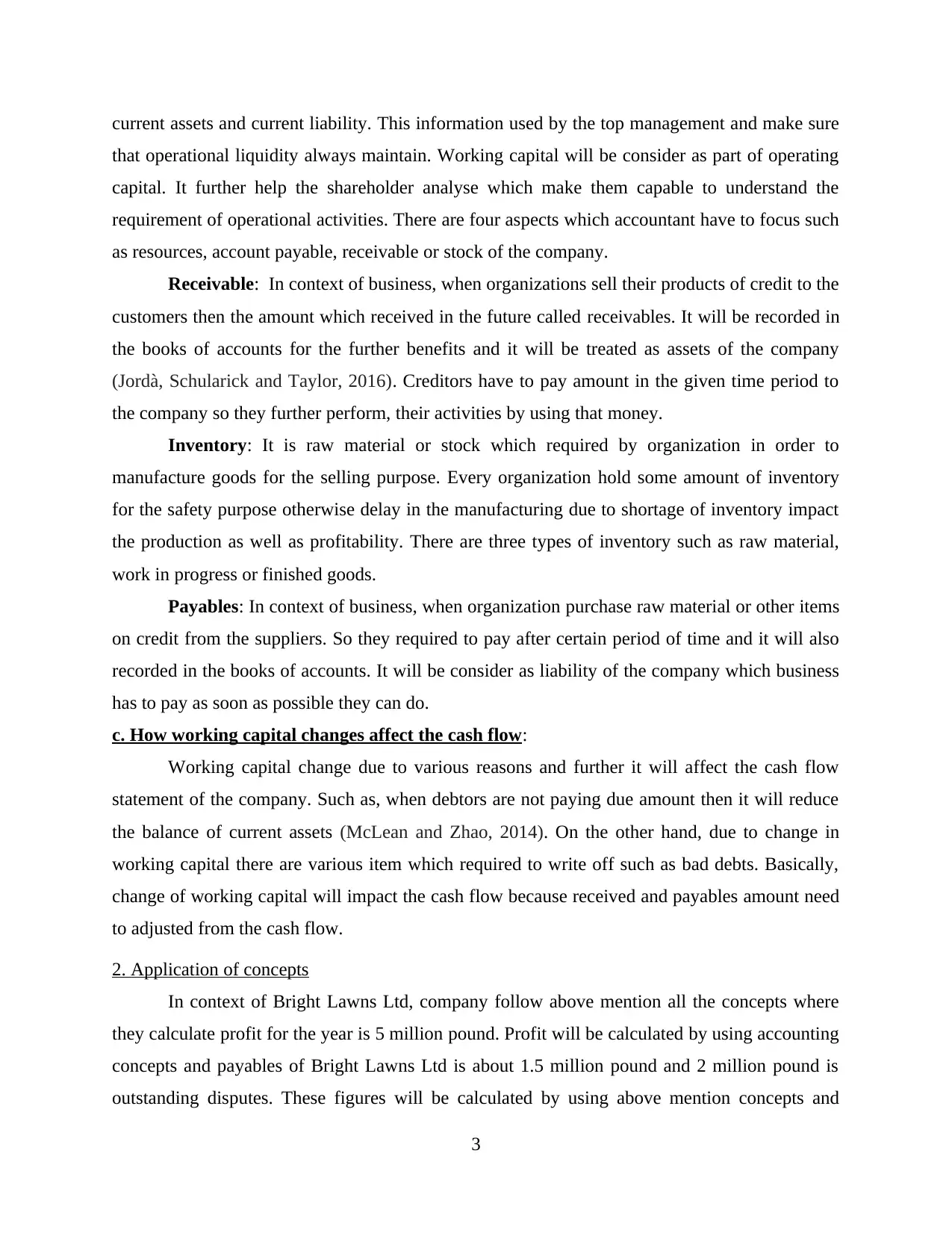
current assets and current liability. This information used by the top management and make sure
that operational liquidity always maintain. Working capital will be consider as part of operating
capital. It further help the shareholder analyse which make them capable to understand the
requirement of operational activities. There are four aspects which accountant have to focus such
as resources, account payable, receivable or stock of the company.
Receivable: In context of business, when organizations sell their products of credit to the
customers then the amount which received in the future called receivables. It will be recorded in
the books of accounts for the further benefits and it will be treated as assets of the company
(Jordà, Schularick and Taylor, 2016). Creditors have to pay amount in the given time period to
the company so they further perform, their activities by using that money.
Inventory: It is raw material or stock which required by organization in order to
manufacture goods for the selling purpose. Every organization hold some amount of inventory
for the safety purpose otherwise delay in the manufacturing due to shortage of inventory impact
the production as well as profitability. There are three types of inventory such as raw material,
work in progress or finished goods.
Payables: In context of business, when organization purchase raw material or other items
on credit from the suppliers. So they required to pay after certain period of time and it will also
recorded in the books of accounts. It will be consider as liability of the company which business
has to pay as soon as possible they can do.
c. How working capital changes affect the cash flow:
Working capital change due to various reasons and further it will affect the cash flow
statement of the company. Such as, when debtors are not paying due amount then it will reduce
the balance of current assets (McLean and Zhao, 2014). On the other hand, due to change in
working capital there are various item which required to write off such as bad debts. Basically,
change of working capital will impact the cash flow because received and payables amount need
to adjusted from the cash flow.
2. Application of concepts
In context of Bright Lawns Ltd, company follow above mention all the concepts where
they calculate profit for the year is 5 million pound. Profit will be calculated by using accounting
concepts and payables of Bright Lawns Ltd is about 1.5 million pound and 2 million pound is
outstanding disputes. These figures will be calculated by using above mention concepts and
3
that operational liquidity always maintain. Working capital will be consider as part of operating
capital. It further help the shareholder analyse which make them capable to understand the
requirement of operational activities. There are four aspects which accountant have to focus such
as resources, account payable, receivable or stock of the company.
Receivable: In context of business, when organizations sell their products of credit to the
customers then the amount which received in the future called receivables. It will be recorded in
the books of accounts for the further benefits and it will be treated as assets of the company
(Jordà, Schularick and Taylor, 2016). Creditors have to pay amount in the given time period to
the company so they further perform, their activities by using that money.
Inventory: It is raw material or stock which required by organization in order to
manufacture goods for the selling purpose. Every organization hold some amount of inventory
for the safety purpose otherwise delay in the manufacturing due to shortage of inventory impact
the production as well as profitability. There are three types of inventory such as raw material,
work in progress or finished goods.
Payables: In context of business, when organization purchase raw material or other items
on credit from the suppliers. So they required to pay after certain period of time and it will also
recorded in the books of accounts. It will be consider as liability of the company which business
has to pay as soon as possible they can do.
c. How working capital changes affect the cash flow:
Working capital change due to various reasons and further it will affect the cash flow
statement of the company. Such as, when debtors are not paying due amount then it will reduce
the balance of current assets (McLean and Zhao, 2014). On the other hand, due to change in
working capital there are various item which required to write off such as bad debts. Basically,
change of working capital will impact the cash flow because received and payables amount need
to adjusted from the cash flow.
2. Application of concepts
In context of Bright Lawns Ltd, company follow above mention all the concepts where
they calculate profit for the year is 5 million pound. Profit will be calculated by using accounting
concepts and payables of Bright Lawns Ltd is about 1.5 million pound and 2 million pound is
outstanding disputes. These figures will be calculated by using above mention concepts and
3
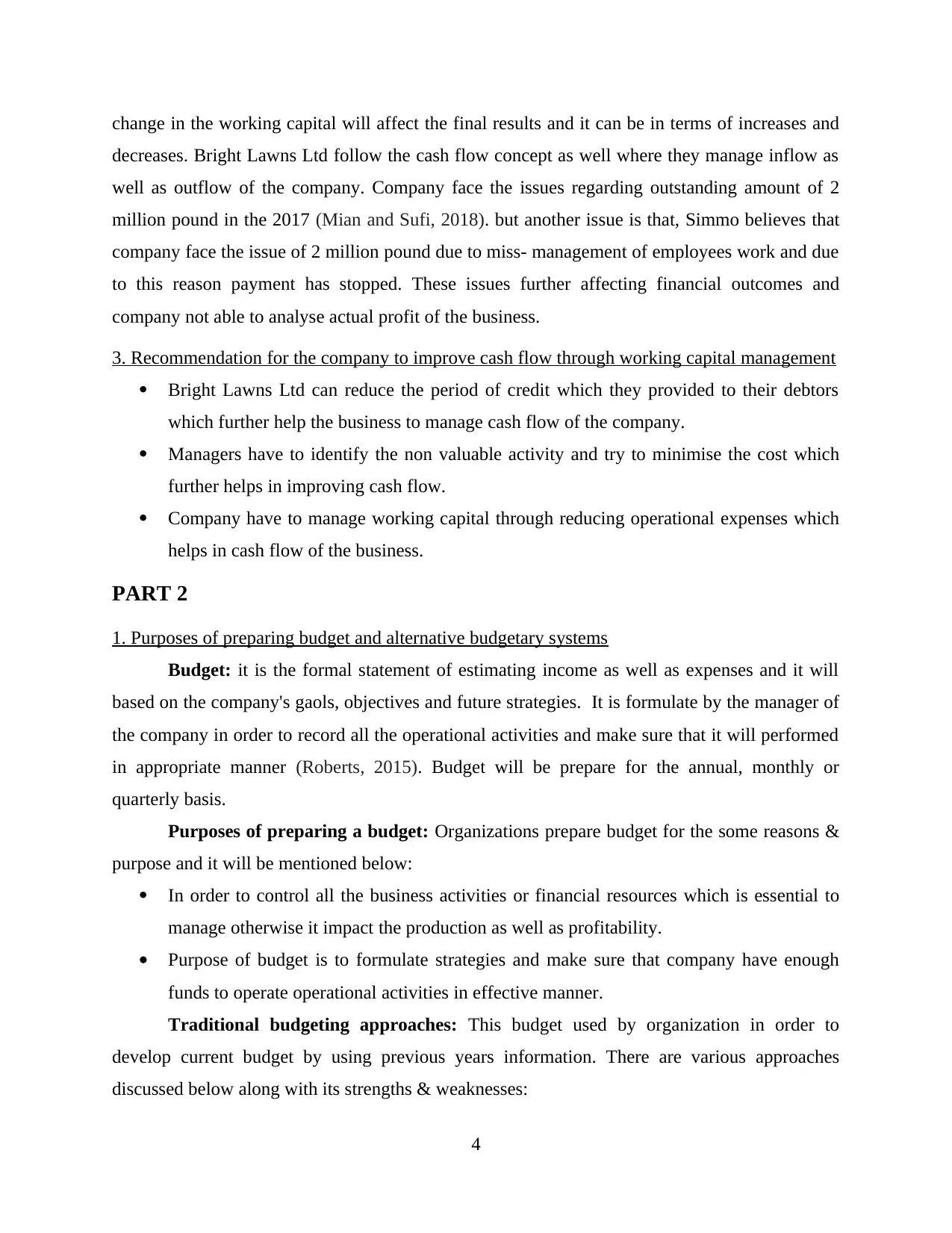
change in the working capital will affect the final results and it can be in terms of increases and
decreases. Bright Lawns Ltd follow the cash flow concept as well where they manage inflow as
well as outflow of the company. Company face the issues regarding outstanding amount of 2
million pound in the 2017 (Mian and Sufi, 2018). but another issue is that, Simmo believes that
company face the issue of 2 million pound due to miss- management of employees work and due
to this reason payment has stopped. These issues further affecting financial outcomes and
company not able to analyse actual profit of the business.
3. Recommendation for the company to improve cash flow through working capital management
Bright Lawns Ltd can reduce the period of credit which they provided to their debtors
which further help the business to manage cash flow of the company.
Managers have to identify the non valuable activity and try to minimise the cost which
further helps in improving cash flow.
Company have to manage working capital through reducing operational expenses which
helps in cash flow of the business.
PART 2
1. Purposes of preparing budget and alternative budgetary systems
Budget: it is the formal statement of estimating income as well as expenses and it will
based on the company's gaols, objectives and future strategies. It is formulate by the manager of
the company in order to record all the operational activities and make sure that it will performed
in appropriate manner (Roberts, 2015). Budget will be prepare for the annual, monthly or
quarterly basis.
Purposes of preparing a budget: Organizations prepare budget for the some reasons &
purpose and it will be mentioned below:
In order to control all the business activities or financial resources which is essential to
manage otherwise it impact the production as well as profitability.
Purpose of budget is to formulate strategies and make sure that company have enough
funds to operate operational activities in effective manner.
Traditional budgeting approaches: This budget used by organization in order to
develop current budget by using previous years information. There are various approaches
discussed below along with its strengths & weaknesses:
4
decreases. Bright Lawns Ltd follow the cash flow concept as well where they manage inflow as
well as outflow of the company. Company face the issues regarding outstanding amount of 2
million pound in the 2017 (Mian and Sufi, 2018). but another issue is that, Simmo believes that
company face the issue of 2 million pound due to miss- management of employees work and due
to this reason payment has stopped. These issues further affecting financial outcomes and
company not able to analyse actual profit of the business.
3. Recommendation for the company to improve cash flow through working capital management
Bright Lawns Ltd can reduce the period of credit which they provided to their debtors
which further help the business to manage cash flow of the company.
Managers have to identify the non valuable activity and try to minimise the cost which
further helps in improving cash flow.
Company have to manage working capital through reducing operational expenses which
helps in cash flow of the business.
PART 2
1. Purposes of preparing budget and alternative budgetary systems
Budget: it is the formal statement of estimating income as well as expenses and it will
based on the company's gaols, objectives and future strategies. It is formulate by the manager of
the company in order to record all the operational activities and make sure that it will performed
in appropriate manner (Roberts, 2015). Budget will be prepare for the annual, monthly or
quarterly basis.
Purposes of preparing a budget: Organizations prepare budget for the some reasons &
purpose and it will be mentioned below:
In order to control all the business activities or financial resources which is essential to
manage otherwise it impact the production as well as profitability.
Purpose of budget is to formulate strategies and make sure that company have enough
funds to operate operational activities in effective manner.
Traditional budgeting approaches: This budget used by organization in order to
develop current budget by using previous years information. There are various approaches
discussed below along with its strengths & weaknesses:
4
⊘ This is a preview!⊘
Do you want full access?
Subscribe today to unlock all pages.

Trusted by 1+ million students worldwide
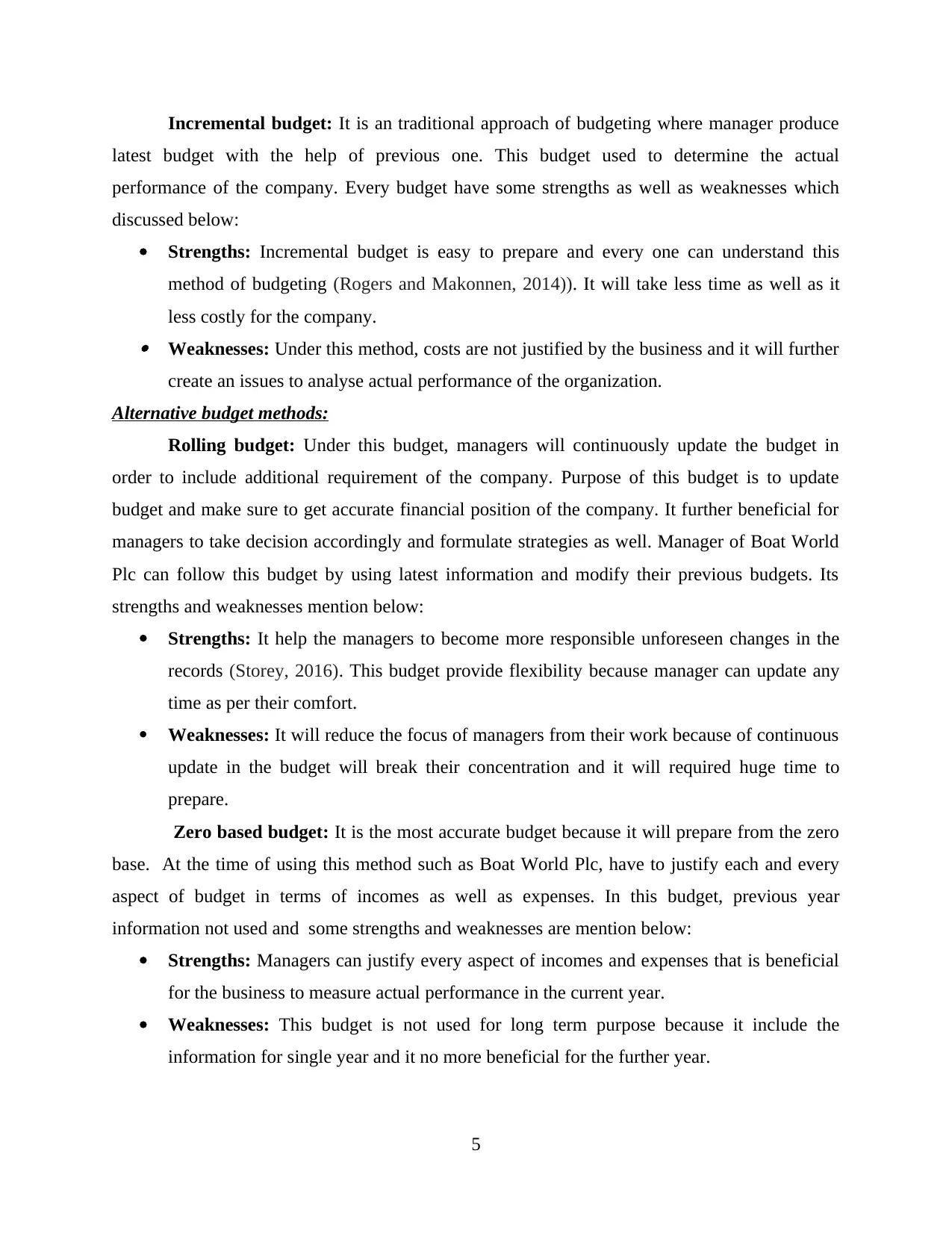
Incremental budget: It is an traditional approach of budgeting where manager produce
latest budget with the help of previous one. This budget used to determine the actual
performance of the company. Every budget have some strengths as well as weaknesses which
discussed below:
Strengths: Incremental budget is easy to prepare and every one can understand this
method of budgeting (Rogers and Makonnen, 2014)). It will take less time as well as it
less costly for the company. Weaknesses: Under this method, costs are not justified by the business and it will further
create an issues to analyse actual performance of the organization.
Alternative budget methods:
Rolling budget: Under this budget, managers will continuously update the budget in
order to include additional requirement of the company. Purpose of this budget is to update
budget and make sure to get accurate financial position of the company. It further beneficial for
managers to take decision accordingly and formulate strategies as well. Manager of Boat World
Plc can follow this budget by using latest information and modify their previous budgets. Its
strengths and weaknesses mention below:
Strengths: It help the managers to become more responsible unforeseen changes in the
records (Storey, 2016). This budget provide flexibility because manager can update any
time as per their comfort.
Weaknesses: It will reduce the focus of managers from their work because of continuous
update in the budget will break their concentration and it will required huge time to
prepare.
Zero based budget: It is the most accurate budget because it will prepare from the zero
base. At the time of using this method such as Boat World Plc, have to justify each and every
aspect of budget in terms of incomes as well as expenses. In this budget, previous year
information not used and some strengths and weaknesses are mention below:
Strengths: Managers can justify every aspect of incomes and expenses that is beneficial
for the business to measure actual performance in the current year.
Weaknesses: This budget is not used for long term purpose because it include the
information for single year and it no more beneficial for the further year.
5
latest budget with the help of previous one. This budget used to determine the actual
performance of the company. Every budget have some strengths as well as weaknesses which
discussed below:
Strengths: Incremental budget is easy to prepare and every one can understand this
method of budgeting (Rogers and Makonnen, 2014)). It will take less time as well as it
less costly for the company. Weaknesses: Under this method, costs are not justified by the business and it will further
create an issues to analyse actual performance of the organization.
Alternative budget methods:
Rolling budget: Under this budget, managers will continuously update the budget in
order to include additional requirement of the company. Purpose of this budget is to update
budget and make sure to get accurate financial position of the company. It further beneficial for
managers to take decision accordingly and formulate strategies as well. Manager of Boat World
Plc can follow this budget by using latest information and modify their previous budgets. Its
strengths and weaknesses mention below:
Strengths: It help the managers to become more responsible unforeseen changes in the
records (Storey, 2016). This budget provide flexibility because manager can update any
time as per their comfort.
Weaknesses: It will reduce the focus of managers from their work because of continuous
update in the budget will break their concentration and it will required huge time to
prepare.
Zero based budget: It is the most accurate budget because it will prepare from the zero
base. At the time of using this method such as Boat World Plc, have to justify each and every
aspect of budget in terms of incomes as well as expenses. In this budget, previous year
information not used and some strengths and weaknesses are mention below:
Strengths: Managers can justify every aspect of incomes and expenses that is beneficial
for the business to measure actual performance in the current year.
Weaknesses: This budget is not used for long term purpose because it include the
information for single year and it no more beneficial for the further year.
5
Paraphrase This Document
Need a fresh take? Get an instant paraphrase of this document with our AI Paraphraser
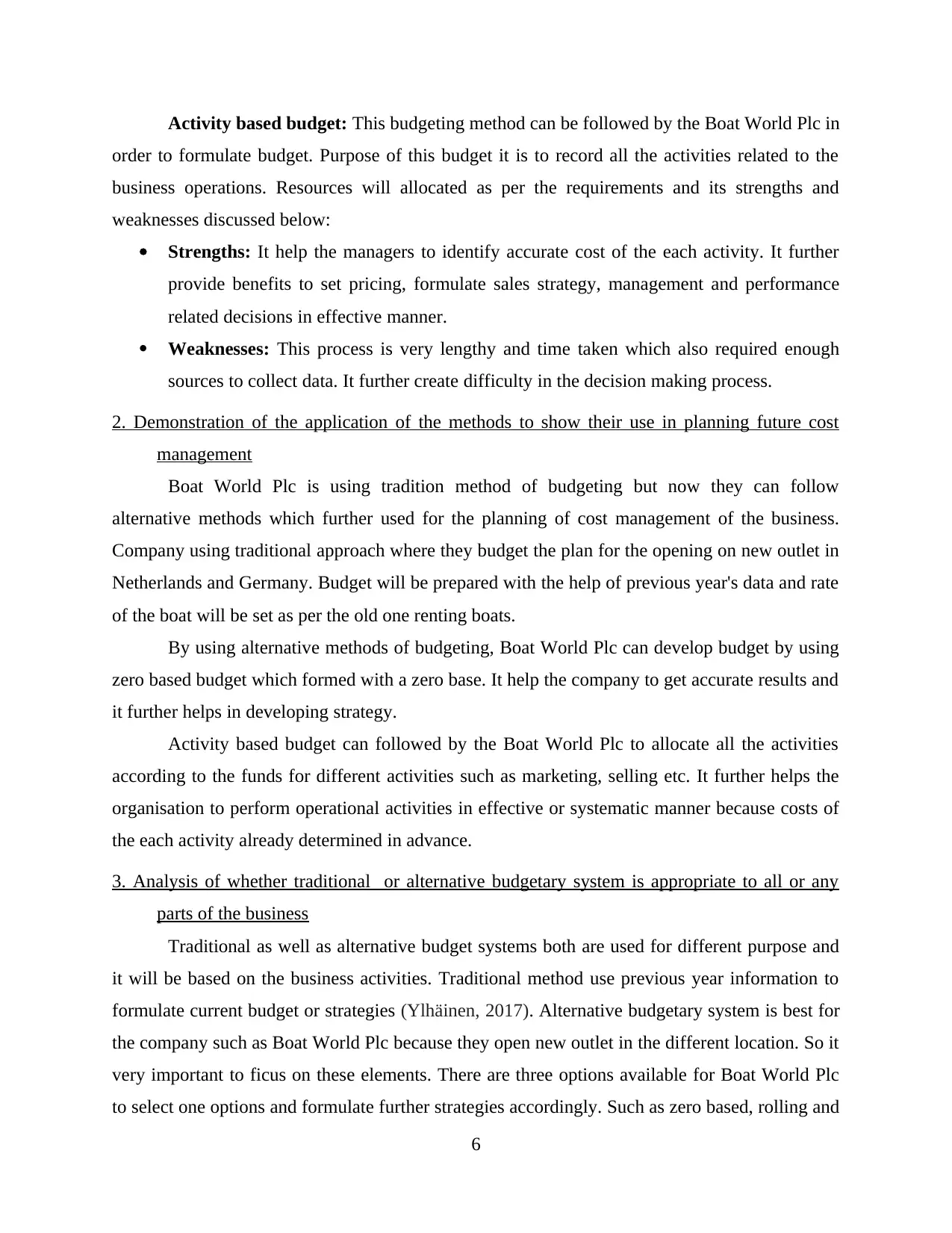
Activity based budget: This budgeting method can be followed by the Boat World Plc in
order to formulate budget. Purpose of this budget it is to record all the activities related to the
business operations. Resources will allocated as per the requirements and its strengths and
weaknesses discussed below:
Strengths: It help the managers to identify accurate cost of the each activity. It further
provide benefits to set pricing, formulate sales strategy, management and performance
related decisions in effective manner.
Weaknesses: This process is very lengthy and time taken which also required enough
sources to collect data. It further create difficulty in the decision making process.
2. Demonstration of the application of the methods to show their use in planning future cost
management
Boat World Plc is using tradition method of budgeting but now they can follow
alternative methods which further used for the planning of cost management of the business.
Company using traditional approach where they budget the plan for the opening on new outlet in
Netherlands and Germany. Budget will be prepared with the help of previous year's data and rate
of the boat will be set as per the old one renting boats.
By using alternative methods of budgeting, Boat World Plc can develop budget by using
zero based budget which formed with a zero base. It help the company to get accurate results and
it further helps in developing strategy.
Activity based budget can followed by the Boat World Plc to allocate all the activities
according to the funds for different activities such as marketing, selling etc. It further helps the
organisation to perform operational activities in effective or systematic manner because costs of
the each activity already determined in advance.
3. Analysis of whether traditional or alternative budgetary system is appropriate to all or any
parts of the business
Traditional as well as alternative budget systems both are used for different purpose and
it will be based on the business activities. Traditional method use previous year information to
formulate current budget or strategies (Ylhäinen, 2017). Alternative budgetary system is best for
the company such as Boat World Plc because they open new outlet in the different location. So it
very important to ficus on these elements. There are three options available for Boat World Plc
to select one options and formulate further strategies accordingly. Such as zero based, rolling and
6
order to formulate budget. Purpose of this budget it is to record all the activities related to the
business operations. Resources will allocated as per the requirements and its strengths and
weaknesses discussed below:
Strengths: It help the managers to identify accurate cost of the each activity. It further
provide benefits to set pricing, formulate sales strategy, management and performance
related decisions in effective manner.
Weaknesses: This process is very lengthy and time taken which also required enough
sources to collect data. It further create difficulty in the decision making process.
2. Demonstration of the application of the methods to show their use in planning future cost
management
Boat World Plc is using tradition method of budgeting but now they can follow
alternative methods which further used for the planning of cost management of the business.
Company using traditional approach where they budget the plan for the opening on new outlet in
Netherlands and Germany. Budget will be prepared with the help of previous year's data and rate
of the boat will be set as per the old one renting boats.
By using alternative methods of budgeting, Boat World Plc can develop budget by using
zero based budget which formed with a zero base. It help the company to get accurate results and
it further helps in developing strategy.
Activity based budget can followed by the Boat World Plc to allocate all the activities
according to the funds for different activities such as marketing, selling etc. It further helps the
organisation to perform operational activities in effective or systematic manner because costs of
the each activity already determined in advance.
3. Analysis of whether traditional or alternative budgetary system is appropriate to all or any
parts of the business
Traditional as well as alternative budget systems both are used for different purpose and
it will be based on the business activities. Traditional method use previous year information to
formulate current budget or strategies (Ylhäinen, 2017). Alternative budgetary system is best for
the company such as Boat World Plc because they open new outlet in the different location. So it
very important to ficus on these elements. There are three options available for Boat World Plc
to select one options and formulate further strategies accordingly. Such as zero based, rolling and
6
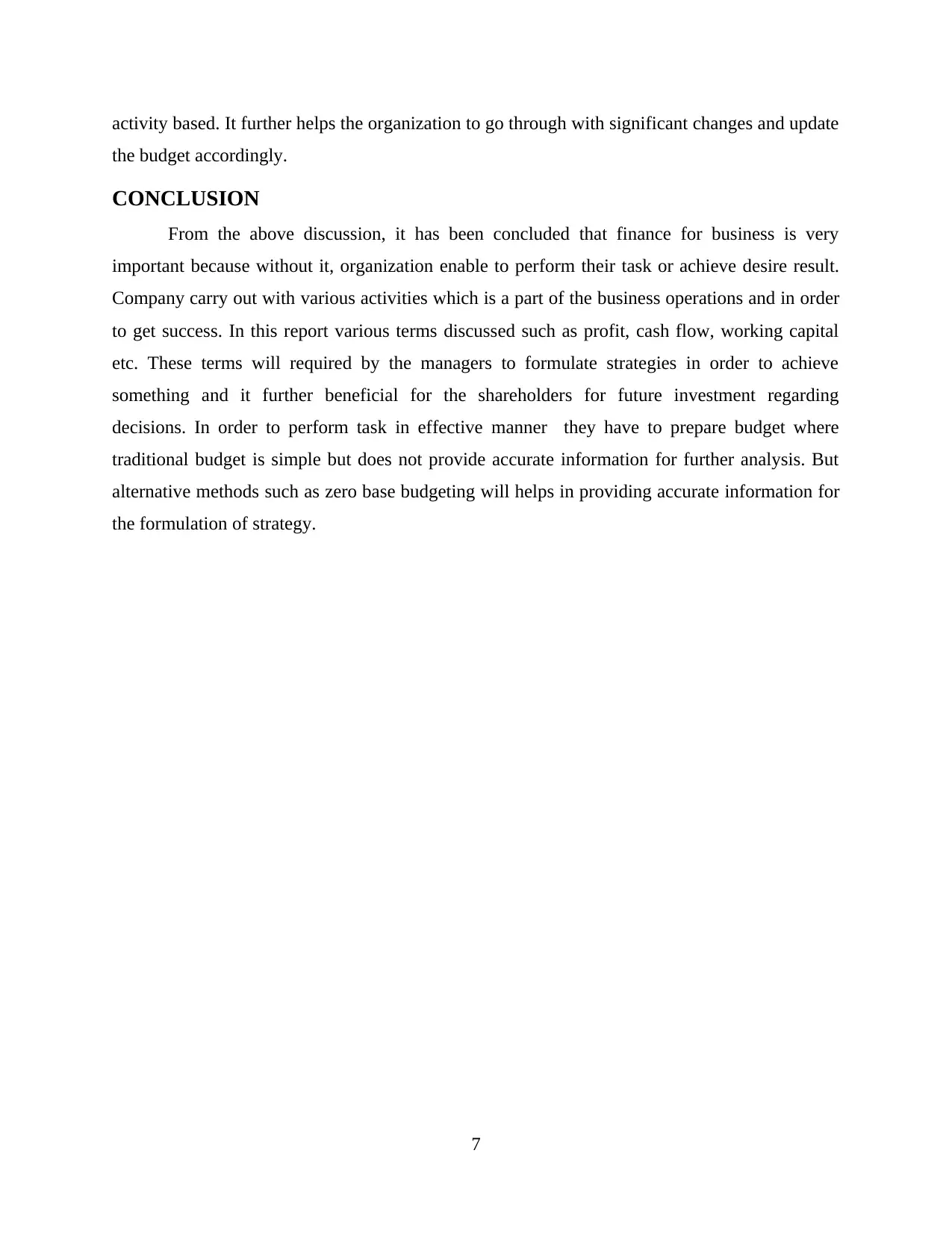
activity based. It further helps the organization to go through with significant changes and update
the budget accordingly.
CONCLUSION
From the above discussion, it has been concluded that finance for business is very
important because without it, organization enable to perform their task or achieve desire result.
Company carry out with various activities which is a part of the business operations and in order
to get success. In this report various terms discussed such as profit, cash flow, working capital
etc. These terms will required by the managers to formulate strategies in order to achieve
something and it further beneficial for the shareholders for future investment regarding
decisions. In order to perform task in effective manner they have to prepare budget where
traditional budget is simple but does not provide accurate information for further analysis. But
alternative methods such as zero base budgeting will helps in providing accurate information for
the formulation of strategy.
7
the budget accordingly.
CONCLUSION
From the above discussion, it has been concluded that finance for business is very
important because without it, organization enable to perform their task or achieve desire result.
Company carry out with various activities which is a part of the business operations and in order
to get success. In this report various terms discussed such as profit, cash flow, working capital
etc. These terms will required by the managers to formulate strategies in order to achieve
something and it further beneficial for the shareholders for future investment regarding
decisions. In order to perform task in effective manner they have to prepare budget where
traditional budget is simple but does not provide accurate information for further analysis. But
alternative methods such as zero base budgeting will helps in providing accurate information for
the formulation of strategy.
7
⊘ This is a preview!⊘
Do you want full access?
Subscribe today to unlock all pages.

Trusted by 1+ million students worldwide
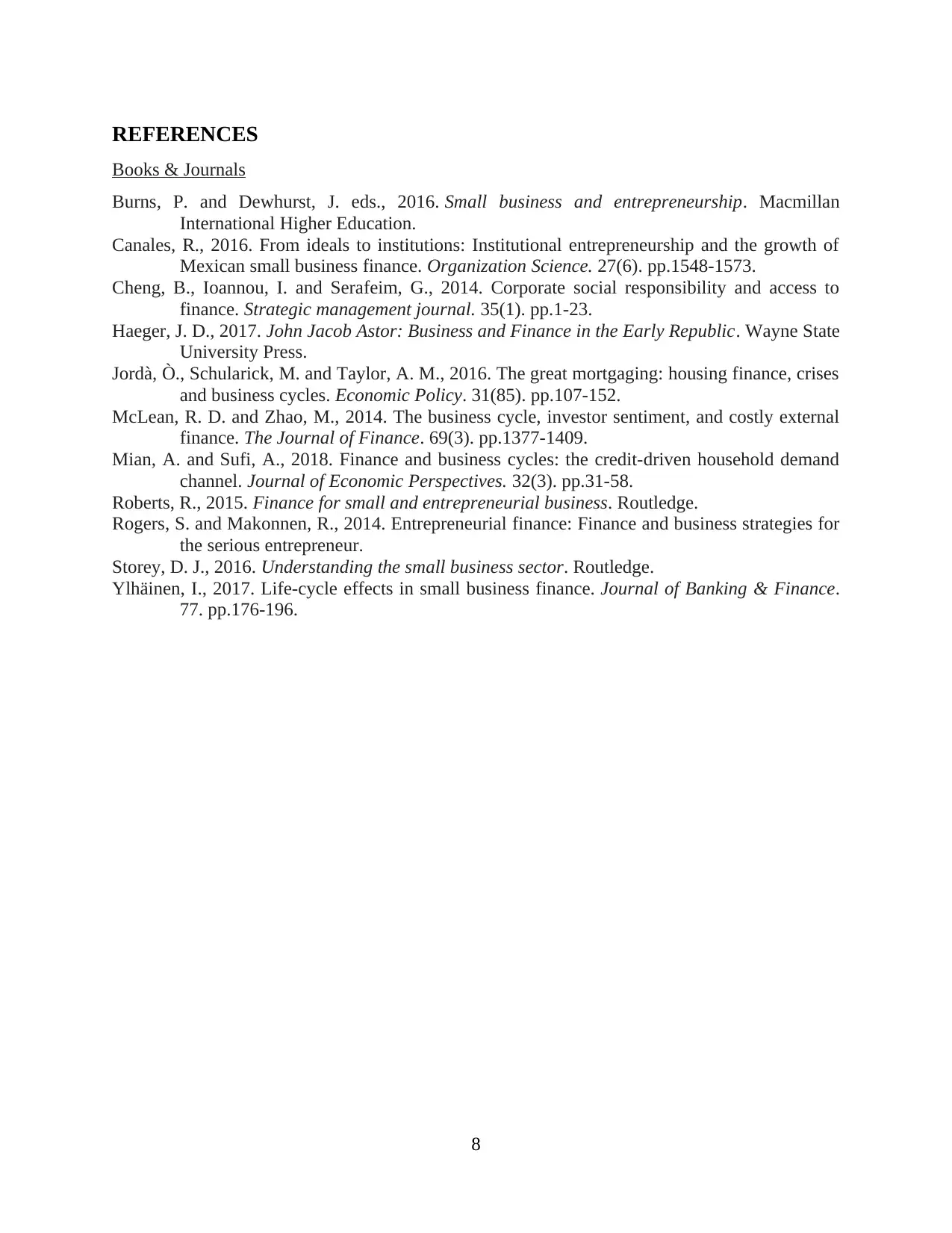
REFERENCES
Books & Journals
Burns, P. and Dewhurst, J. eds., 2016. Small business and entrepreneurship. Macmillan
International Higher Education.
Canales, R., 2016. From ideals to institutions: Institutional entrepreneurship and the growth of
Mexican small business finance. Organization Science. 27(6). pp.1548-1573.
Cheng, B., Ioannou, I. and Serafeim, G., 2014. Corporate social responsibility and access to
finance. Strategic management journal. 35(1). pp.1-23.
Haeger, J. D., 2017. John Jacob Astor: Business and Finance in the Early Republic. Wayne State
University Press.
Jordà, Ò., Schularick, M. and Taylor, A. M., 2016. The great mortgaging: housing finance, crises
and business cycles. Economic Policy. 31(85). pp.107-152.
McLean, R. D. and Zhao, M., 2014. The business cycle, investor sentiment, and costly external
finance. The Journal of Finance. 69(3). pp.1377-1409.
Mian, A. and Sufi, A., 2018. Finance and business cycles: the credit-driven household demand
channel. Journal of Economic Perspectives. 32(3). pp.31-58.
Roberts, R., 2015. Finance for small and entrepreneurial business. Routledge.
Rogers, S. and Makonnen, R., 2014. Entrepreneurial finance: Finance and business strategies for
the serious entrepreneur.
Storey, D. J., 2016. Understanding the small business sector. Routledge.
Ylhäinen, I., 2017. Life-cycle effects in small business finance. Journal of Banking & Finance.
77. pp.176-196.
8
Books & Journals
Burns, P. and Dewhurst, J. eds., 2016. Small business and entrepreneurship. Macmillan
International Higher Education.
Canales, R., 2016. From ideals to institutions: Institutional entrepreneurship and the growth of
Mexican small business finance. Organization Science. 27(6). pp.1548-1573.
Cheng, B., Ioannou, I. and Serafeim, G., 2014. Corporate social responsibility and access to
finance. Strategic management journal. 35(1). pp.1-23.
Haeger, J. D., 2017. John Jacob Astor: Business and Finance in the Early Republic. Wayne State
University Press.
Jordà, Ò., Schularick, M. and Taylor, A. M., 2016. The great mortgaging: housing finance, crises
and business cycles. Economic Policy. 31(85). pp.107-152.
McLean, R. D. and Zhao, M., 2014. The business cycle, investor sentiment, and costly external
finance. The Journal of Finance. 69(3). pp.1377-1409.
Mian, A. and Sufi, A., 2018. Finance and business cycles: the credit-driven household demand
channel. Journal of Economic Perspectives. 32(3). pp.31-58.
Roberts, R., 2015. Finance for small and entrepreneurial business. Routledge.
Rogers, S. and Makonnen, R., 2014. Entrepreneurial finance: Finance and business strategies for
the serious entrepreneur.
Storey, D. J., 2016. Understanding the small business sector. Routledge.
Ylhäinen, I., 2017. Life-cycle effects in small business finance. Journal of Banking & Finance.
77. pp.176-196.
8
1 out of 10
Related Documents
Your All-in-One AI-Powered Toolkit for Academic Success.
+13062052269
info@desklib.com
Available 24*7 on WhatsApp / Email
![[object Object]](/_next/static/media/star-bottom.7253800d.svg)
Unlock your academic potential
Copyright © 2020–2025 A2Z Services. All Rights Reserved. Developed and managed by ZUCOL.




